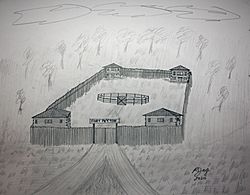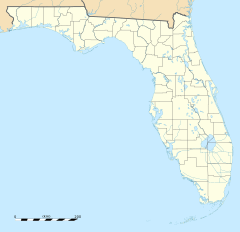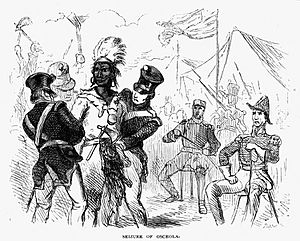Fort Peyton facts for kids
Quick facts for kids Fort Peyton |
|
|---|---|
| South of Moultrie Creek Near St. Augustine, Florida in United States |
|

Fort Peyton - Second Seminole War Fort (artist's depiction).
|
|
|
Location of Fort Peyton
|
|
| Coordinates | 29°49′29″N 81°21′36″W / 29.82472°N 81.36000°W |
| Site history | |
| Built | August 1837 |
| Built by | United States Army |
| In use | 1840 |
| Materials | Pine log stockade and buildings |
| Fate | Abandoned in May 1840, burnt to the ground on February 14, 1842 |
| Events | Capture of Seminole leader Osceola occurred nearby on October 21, 1837 |
| Garrison information | |
| Past commanders |
Lt. Richard H. Peyton |
| Garrison | Regular army troops |
Fort Peyton was a fort built in August 1837 by the United States Army. It was made of pine logs and was surrounded by a strong fence called a stockade. This fort was one of many military outposts built during the Second Seminole War. Its main job was to protect the St. Augustine area in Florida Territory. Major General Thomas Jesup ordered the fort to be built. Regular army soldiers lived and worked there.
The fort was located about seven miles southwest of St. Augustine. It stood on the south side of Moultrie Creek. This was the same place where the Treaty of Moultrie Creek was signed in 1823. That treaty was an agreement between the U.S. government and the leaders of several Seminole groups. A very important event happened near Fort Peyton. On October 21, 1837, the famous Seminole leader Osceola was captured. He was taken prisoner about a mile south of the fort. This happened when he was under a "white flag of truce." This flag usually means people can talk safely without fighting. General Joseph Marion Hernández captured Osceola under orders from General Thomas Jesup.
Contents
History of Fort Peyton
The Capture of Osceola
On October 20, 1837, Osceola sent a message to General Joseph Hernández. He wanted to meet and talk. Osceola sent a trusted interpreter named Juan Caballo, also known as John Horse. John Horse was a Black Seminole. General Jesup told Hernández to agree to the meeting. But Jesup also secretly ordered Hernández to capture Osceola and another leader, Coe Hadjo, when they arrived.
The next day, October 21, Osceola and Coe Hadjo waited for Hernández. They were about eight miles south of St. Augustine. About 71 Seminole warriors, six women, and four Black Seminole warriors were with them. Osceola asked for General Jesup to come out and talk. But Jesup stayed inside Fort Peyton. He told Lieutenant Peyton to try and convince Osceola and his men to come into the fort. The plan was to capture them once they were inside.
However, Osceola refused to enter the fort. So, General Hernández rode out from St. Augustine to talk with the Native Americans. He brought 250 dragoons with him. Dragoons were soldiers who rode horses. These soldiers were led by Major James A. Ashby. They all rode to Fort Peyton.
Meanwhile, General Jesup sent Lieutenant Peyton to check on the meeting. Lieutenant Peyton reported that the answers from the Native Americans were not clear. They were "evasive and unsatisfactory." Because of this, Jesup gave a new order. He told Major Ashby to capture Osceola and his group. This order was given even though the meeting was happening under a white flag of truce.
Major Ashby followed the orders. With help from Hernández, he captured 75 armed Native American warriors. Osceola was among them. No shots were fired during the capture. Many people thought this action was very wrong. It was seen as a serious break of the laws of warfare. General Jesup was criticized in newspapers and by the public for what he did.
About Fort Peyton
Fort Peyton was first called Fort Moultrie. Its name was changed to honor Lieutenant Richard H. Peyton. He was the fort's commander in 1837. Lieutenant Peyton died in 1839.
A historian named Charles H. Coe wrote a book in 1898. In his book, Red Patriots: The Story of the Seminoles, he mentions John H. Masters. Masters was a sergeant who helped capture Osceola. Many years later, Masters showed members of the St. Augustine Historical Society the exact spot where Osceola was captured. A special marker was placed there in 1916. It was made of coquina stone and had a plaque. However, in 2001, someone from the Historical Society said the actual spot might be a little different from what was shown on an old map from the 1850s.
Historical Sign at Fort Peyton
There is a historical sign at the site of Fort Peyton today. It tells us more about the fort: "Fort Peyton was built by Major General Thomas Sidney Jesup in August 1837. Regular army troops were stationed there. It was one of many military outposts built during the Second Seminole War. These forts protected the St. Augustine area. Fort Peyton had four log houses built in a square. Two houses were for the troops, one for officers, and the fourth was a hospital and supply store. The fort was first called Fort Moultrie. Its name was changed to honor Lieutenant Richard H. Peyton, who commanded the fort in 1837. The Seminole leader, Osceola, was captured about a mile south of this site. The Secretary of War, Joel R. Poinsett, ordered Fort Peyton to be abandoned in May 1840. The buildings burned down on February 14, 1842. People believe someone purposely set them on fire."
Forts Near St. Augustine During the Second Seminole War
During the Second Seminole War, many forts were built near St. Augustine. These forts were placed along important roads and waterways. Their purpose was to protect large farms, called plantations, from attacks by Seminole Native Americans. These forts were usually simple buildings. They served as places to store supplies, connect transportation and communication, ship goods, and treat wounded soldiers. They also provided housing for U.S. Army troops and local soldiers. Many of these forts were left empty by the U.S. Army or local soldiers. When the Seminoles found them empty, they would take any supplies they could find and then burn the forts.
Besides Fort Peyton and Fort Hanson, many other forts were built or used by the U.S. Army near St. Augustine. These forts helped defend the large plantations that were important for the war and the local economy. Some of these forts included: the Addison Blockhouse (also called Fort Duncan McRee), Camp Darley, Camp Dunlawton, Fort Barnwell (also called Fort Columbia), Fort Birch, Fort Caben, Fort Fulton, Fort Call, Fort Florida, Fort Kingsbury, Fort New Smyrna, Fort Volusia, St. Joseph's Fortress (also called Camp Brisbane), Post at Orange Grove Plantation, and the Mala Compra Fortress (also called Post at Mala Compra).
Fort Peyton Today
Today, the area where Fort Peyton once stood is covered with thick trees and plants. You can reach it by driving on a dirt road. The only things left that show where the fort was are a concrete marker and a historical sign.








